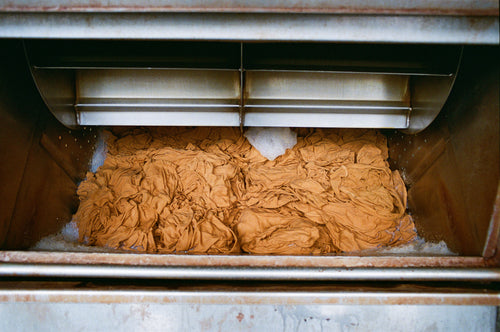Botanical Dyes
April 24, 2021 - New York City, NY - Factory Visits
This weekend, we visited Green Matters Natural Dye Company in Pennsylvania to put the final touches on our sweatshirts. Releasing this September, our recycled cotton hoodies feature two earthy botanical dye treatments. We first approached sweatshirts as the optimal test for circular product design both upstream and down. In short, we must account for both cutting waste and the customer's relationship with the product. To learn more about rethinking a relatively typical garment, click here. Aesthetic creativity is simpler when you set moral boundaries, and botanical dyes sit at the crossroads of decoration and intentional production.
17 to 20% of all industrial water pollution is owed to fabric dyes and treatments.
Green Matters Natural Dye Company is a seven person team in Gap, Pennsylvania specializing in small batch natural dye jobs. The workshop was founded by Winona Quigley in an effort to challenge the immense amount of water waste and toxic runoff produced by the garment industry. To put it in perspective, the industry uses 79 billion cubic meters of water each year, and according to the UN over 80% of wastewater is returned to the environment untreated. Synthetic dyes are a huge contributor to this: they use and contaminate a lot of water. On the contrary, Green Matters uses only rainwater to refill the 60,000 gallon cistern located beneath the facility. You can see the very human measuring system below: a rod, a buoy, and a marking on the wall. As for the toxicity, both the pigments and mordants are 100% compostable; because they are free from harmful chemicals they can also be leveraged as fertilizer in their next life. This is the beauty of natural dyes. There is no chromium, lead, or cadmium present. While these are the most well known toxins, there are an estimated 8,000 synthetic chemicals used to dye, treat, and brighten clothing. At Green Matters, natural materials such as avocado, turmeric, and walnuts lend their color instead.


In business since 2015, Green Matters has also impressed us with their ongoing research. They grow pigments aeroponically on site and collect enough food waste, such as avocado pits, from local restaurants to dye high volume projects. Their processes are both environmentally sound and aesthetically pleasing. Compared to the synthetics we are accustomed to, natural dye jobs lead to more texture, softer colors, and increased character with wear. The first two are a given, who wouldn't want a more interesting and relatable color profile? The aging and care is where things can get complicated from a consumer’s perspective.
Due to the inhuman uniformity and permanence of synthetic fibers and dyes, wearers have become accustomed to garments holding their neon green or royal blue identities. The perceived value of clothing does not account for environmental and ethical costs of synthetics, as consumers are rarely privy to how and why a garment is made. This issue crosses fiber use, worker rights, international trade, buying patterns, repair habits, and many other areas. To start, we hope our customers value the natural dyeing process and its purpose. Rather than being upset by any changes to a garment’s color or texture as it ages, we should appreciate them. With increased curiosity, we will want to repair our garments - and, in this case, redye them.
Save your avocado pits.







